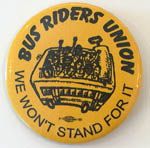Mass transit for poor frowned on in Bay Area
by Chris Reed | May 8, 2014 2:00 pm
There’s plenty of research that shows that bus rapid transit is far the most cost-effective type of mass transit, with a flexibility that’s particularly helpful to the less affluent. This is from a Reason Foundation study[1] released in January about the shortfalls of the traditional, rail-centric approach to mass transit:
“Yet despite transit’s importance, most metropolitan transit systems are inadequate. In no major metropolitan area, for example, are more than 12.6% of jobs accessible within a 45-minute, one-way commute via transit. This is particularly problematic for poorer metropolitan-area residents, who are most likely to be transit-dependent.
“Why is transit so inadequate? One reason is that while many metropolitan areas maintain ‘radial’ transit networks designed to transport workers to and from a traditional central business district, patterns of economic activity have actually become increasingly decentralized. Research shows that nearly half the jobs in the nation’s largest metropolitan areas are located more than 10 miles from the edge of the central business district, while only 20% of jobs are located within three miles of downtown. In this context, ‘grid’ transit networks—which do a much better job of connecting suburbs with one another—are more effective than radial ones.
‘Supposed to be the future of public transportation’
 [2]Fixed-rail mass transit just can’t compare with small bus fleets in getting people from where they live to where they work. So one would think that as a matter of social justice, bus rapid transit would be hugely popular in liberal communities?
[2]Fixed-rail mass transit just can’t compare with small bus fleets in getting people from where they live to where they work. So one would think that as a matter of social justice, bus rapid transit would be hugely popular in liberal communities?
Nope. Not even close. A San Francisco Chronicle story[3] shows that in the Bay Area, the transit approach has been stalled:
“Bus rapid transit was supposed to be the future of public transportation.
“A technology combining more efficient buses and relatively simple improvements to streets, BRT, as it’s known, has been heralded as a fairly cheap high-capacity transit system — a subway on tires — that can be put on the streets quickly.
“But in the Bay Area, the introduction of bus rapid transit is advancing at a pace akin to that of a Muni bus stuck in rush-hour traffic. More than a dozen years after the region started talking about the speedy buses, the Bay Area is still waiting for its first one.
“Bus rapid transit projects in San Francisco, the East Bay and the South Bay are still in the works, but they have stalled after running into community skepticism and opposition to the removal of traffic lanes and parking spaces. The opposition from merchants and residents has caused some cities, even progressive bastions like Berkeley, to refuse to allow transit-only lanes or to drop out of BRT projects altogether.”
The Chronicle article ignores two crucial issues. The first is that the Bay Area loves the mass transit program whose main ridership is middle-class and upper-middle-class — the Bay Area Rapid Transit system. The second is that historically one of the reasons bus rapid transit has been so opposed is because it involves vehicles. Even if they’re vehicles that don’t have internal combustion engines, liberals don’t like vehicles — outside of their own.
Poor sued over rail-favoring transit policies in L.A.
 In the early 1990s, this attitude led to a social-justice lawsuit in Los Angeles. This story[4] is from the Dec. 31, 1996, Los Angeles Times:
In the early 1990s, this attitude led to a social-justice lawsuit in Los Angeles. This story[4] is from the Dec. 31, 1996, Los Angeles Times:
“When it began in 1992 as the brainchild of labor and environmental activist Eric Mann, the Bus Riders Union was seen by some as a gadfly group whose members had been escorted out of MTA meetings by transit police.
“Now, the group has won official recognition and a place at the decision-making table. With the October settlement of its lawsuit against the MTA, the Bus Riders Union is included in a joint working group with MTA officials that will oversee the implementation of future bus improvements.
“But the group’s recent success is just one part of its broader goals.
“‘Building a first-class bus system is part of building a social movement,’ organizer Kikanza Ramsey said. To the Bus Riders Union, better buses are an important improvement–along with better wages and working conditions and a cleaner environment–to the quality of life of poor and minority Los Angeles residents.
“The union contends that improving the bus system is a civil rights issue because most bus riders are minorities and have low incomes. Forty-seven percent of bus riders are Latinos, 23% are African American, 19% are white and 8% are Asian Americans or Pacific Islanders.
“Its suit alleged that massive spending on rail projects diverted funds from poor and minority bus riders.”
Bingo.
- Reason Foundation study: http://reason.org/news/show/bus-rapid-transit-and-managed-lanes
- [Image]: http://calwatchdog.com/wp-content/uploads/2013/11/BART.gif
- San Francisco Chronicle story: http://www.sfgate.com/bayarea/article/Why-bus-rapid-transit-has-stalled-in-Bay-Area-5461409.php
- story: http://articles.latimes.com/1996-12-31/local/me-14193_1_bus-riders-union
Source URL: https://calwatchdog.com/2014/05/08/mass-transit-for-poor-frowned-on-in-bay-area/